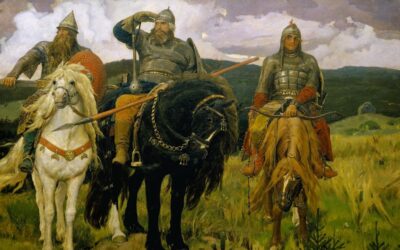In honor of St. Patrick’s Day, I’m reposting an article on the Celtic Cross that I wrote years ago that is no longer available. Along with this, I just posted a short video on St. Patrick and Celtic Christianity that talks about the little known impact of the early Irish church.
In the ruins of the Abbey of Monasterboice, County Louth, Ireland, are three High Crosses. On the southernmost of these crosses is an inscription that reads, “ÓR DO MUIREDACH LAS NDERNAD IN CHROS,” or in English, “A prayer for Muiredach [pronounced “Murdock”] who had this cross made.”
Who was Muiredach? We don’t know for sure. There were two different abbots at the monastery and a local king who had that name in the period that the cross was carved, so there is no way to determine his identity definitively. What is more important is the cross itself and what it signified.
The Sun Cross
The symbolism of the Celtic cross goes back to pre-Christian paganism. One of the key symbols of northern European pagan peoples—Celtic, Germanic, and Slavic alike—was the “sun cross,” a circle with a cross inside it. Although most scholars see this as simply a symbol of the sun, surviving pagan traditions in the Slavic regions show that it was far more than that. It was a symbolic representation not so much of the sun, but of the whole world.

The cross pointed to four cardinal directions, with east on the left, south on top, west on the right, and north on the bottom. The vertical line represented the “world tree” (Yggdrasil in Norse mythology), which tied the worlds together. The bottom was anchored in the underworld, the realm of the dead, and the top reached to heaven, the realm of the gods. The horizontal line represented this world, or “middle earth” between the lower and upper worlds. All that exists was thus symbolically represented in the diagram.
Along with the underworld, the roots of the tree connected to ancestral wisdom and tradition, while the top of the tree represented divine wisdom. The sources of knowledge were thus also included in the symbolism.

Beyond even this, time is also represented by the diagram. The left side (east) represents dawn; the top (south, where the sun is the strongest), noon; the right (west), dusk; the bottom (north, where the sun is weakest), midnight. The same directions also represent the annual cycle: the left, spring; the top, summer; the right, autumn; the bottom, winter. Along with chronological time, they also represent the seasons of human life: the left, birth; the top, youth; the right, maturity; the bottom, old age. The circle that encloses the cross points to the circle of time, as day turns to day in an endless cycle, year turns to year, and as human life is passed to the next generation.

The sun cross thus represented far more than the sun: it pointed to all of space and time and all of the knowledge and wisdom in the heavens, on earth, and under the earth.
The Celtic Cross
Irish monks on the sacred island of Iona took this well-known image and transformed it from its pagan origins into a very powerful symbol for the Gospel. They superimposed over the ancient mandala the cross of Christ (using the Latin cross as their model) to create what we know today as the Celtic cross.

In its cultural context, this cross proclaims Christ as Lord of space and time and the fount of all wisdom and knowledge, ruling over all things from the cross. It is a profound picture of the Irish saints’ vision of the Gospel of the kingdom of God and of Jesus’ authority over all places and times and every moment of our lives.
Irish High Crosses
The symbolism of the Celtic cross was profound and powerful, but the High Crosses of Ireland took this even further. The ancient inhabitants of Europe erected menhirs, enormous standing stones, particularly in Ireland, Britain, and Brittany. These date back six to seven thousand years, placing them in the Neolithic period. In the middle ages, it was believed that these were set up by giants who lived before Noah’s flood. No one knows what their original purpose was, but as Celtic peoples migrated into the areas over the millennia, they incorporated the menhirs into their religious practices as sacred objects.
When Ireland became Christianized, some of the old pagan holy sites were converted to churches and monasteries. The standing stones had no real use any more. Legends would accumulate around them: one ring of standing stones was said to be nine maidens who had been changed to stone while dancing, for example. In general, the menhirs continued to be associated with paganism. By the eighth century, with paganism long gone, monks on the island of Iona decided to erect their own standing stones in honor of Jesus. And these, of course, were done in the form of a cross.
This provides yet another layer of meaning to the High Crosses: just as the Celtic cross represented a reinterpretation and Christianization of the sun cross, so the High Crosses are visible images of the triumph of Christianity over paganism. To use a popular metaphor in the middle ages, just as the Israelites plundered the wealth of the Egyptians in the Exodus, so the Irish monks were plundering the wealth of their pagan forbearers in the creation of the High Crosses.
Muiredach’s Cross
The crosses themselves are beautifully decorated, with biblical scenes, geometric patterns, and images from nature carved onto all the faces. All are unique, and all anonymous; only Muiredach’s has a name attached to it, and that is the patron’s, not the artist’s. All are worth studying, but here we’ll just focus on the imagery from Muiredach’s Cross.
On the west side, most of the images come from Jesus’s passion and resurrection: Gethsemane is at the bottom; the crucifixion is at the center within the circle, with Christ portrayed not as suffering, but triumphant; the resurrection is on the right arm; Jesus appearing to Thomas and the commissioning of Peter and Paul are also shown. At the very top, carved from a separate piece of stone to resemble a reliquary (i.e. a container for relics), is Moses praying, with Aaron and Hur supporting his arms at the Battle of Rephidim (Ex. 17:8-16).
On the east side, the focus shifts to a cosmic vision of history, emphasizing typology and the connections between sin, redemptive history, Irish monasticism, and judgment. At the base, we see Adam and Eve and the Fall in the Garden of Eden, along with Cain’s murder of Abel. Next, we see David and Goliath. David was the ancestor of Jesus and the author of many of the Psalms, the backbone of Irish spirituality.
We then move to Moses drawing water from the rock, which was understood to be a type of Christ giving living water to his people. Just below the circle, we have the adoration of the magi (four of them). Within the central circle is Christ seated in judgment, sending the damned to Hell and the saved to Heaven; David is seated at his right side, playing the harp. At the top, we find Sts. Anthony and Paul of Thebes, the first monk and the first hermit, the twin inspirations of much of Celtic monasticism.
The cross is thus more than a simple statement of the triumph of Christianity over paganism or a worldview statement about the Lordship of Christ. Its imagery contains a rich theology, connecting the Old Testament to the New and showing the sweep of history from Fall through redemption and our eternal fate.
Muiredach’s cross didn’t change the world, but it reveals a world changed by the Gospel, and shows the passion and zeal of the Irish Christians who did change their world through their scholarship and their missionary activity. In a nearly perfect melding of art and the biblical worldview, they proclaim loudly and clearly Jesus as Lord of time and space, the source of wisdom, and the transformer of culture.



0 Comments
Trackbacks/Pingbacks